|
Mississippi Delta Whitetail Deer Hunting
|
Welcome
|
Thacker Mountain Lodge offers Mississippi Delta Guided deer hunts. Our Mississippi Delta Guided hunts offer an opportunity to hunt Delta deer where you can harvest some big deer and some average deer. Our Mississippi Guided deer hunts lets you hunt deer in the pristine Mississippi Delta area where the right soil and food sources let the delta deer population reach the maximum capacity of the land. On our Delta guided deer hunts we can promise a quality time and lots of great memories. When you choose Delta deer hunts remember that the Delta deer usually are much bigger in body weight. So, for our Mississippi guided deer hunts we encourage you to shoot a doe first and then to harvest a buck. Try our Mississippi guided hunts this fall. Bring your friends or your family and experience Mississippi whitetail deer hunting at its best. Deer hunting is what we do best!
|

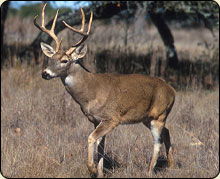 Mississippi Whitetail Deer Discription
Mississippi Whitetail Deer Discription
|
The Mississippi Delta Whitetailed deer's coat is a reddish-brown in the spring and summer and turns to a grey-brown throughout the fall and winter. The deer can be recognized by the characteristic white underside to its tail, which it shows as a signal of alarm by raising the tail during escape.
Mississippi Delta White-tailed male deer (also known as a buck) usually weighs from 130 to 300 pounds (60 to 130 kg) but, in rare cases, bucks in excess of 375 pounds (159 kg) have been recorded. The record-sized White-tailed Deer weighed just over 500 pounds and was found in Minnesota. The female (doe) usually weighs from 90 to 165 pounds (40 to 75 kg), but some can weigh as much as 200 to 230 pounds (90 to 105 kg). Length ranges from 62 to 87 inches (160 to 220 cm), including the tail, and the shoulder height is 32 to 40 inches (80 to 100 cm). Whitetailed deer from the tropics tend to be much smaller than temperate populations, averaging 77-110 pounds (35-50 kg).
|

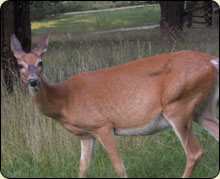 Mississippi Whitetail Deer Diet
Mississippi Whitetail Deer Diet
The Mississippi Delta White-tailed deer is a ruminant, which means it has a four-chambered stomach. Each chamber has a different and specific function that allows it to quickly eat a variety of different food, digesting it at a later time in a safe area of cover.
Mississippi Delta White-tailed deer eat large varieties of food, commonly eating legumes and foraging on other plants, including shoots, leaves, cactus, and grasses. They also eat acorns, fruit, and field corn or any kind of corn. Their special stomach allows them to eat some things that humans cannot, such as mushrooms that are poisonous to humans and Red Sumac. Their diet varies in the seasons according to availability of food sources. They will also eat hay and other food that they can find in a farm yard. Whitetail deer have been known to opportunistically feed on nestling songbirds, as well as birds trapped in Mist nets.
The Mississippi Whitetail deer stomach hosts a complex set of bacteria that change as the deer's diet changes through the seasons. If the bacteria necessary for digestion of a particular food stuff (hay, e.g.) are absent it will not be digested. Thacker Mountain Lodge offers Mississippi guided deer hunts, Mississippi guided delta deer hunts, and Mississippi guide rifle and bow, or archery hunts for Mississippi Whitetail deer.
|

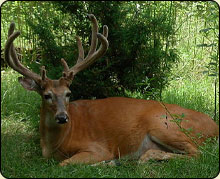 Mississippi Whitetail Bucks
Mississippi Whitetail Bucks
Mississippi Delta White-tailed deer Males re-grow their antlers every year. About 1 in 10,000 females also have antlers, although this is usually associated with hermaphroditism. Bucks with very small antlers, about 3 in (7 cm) or less, are often termed "button bucks" or "spiked bucks". Some may even have their antler pedicles hidden in the hair and can be mistaken for a doe. Bucks less than two years of age typically have short spiked antlers. However the number of points or thickness of the antlers do not determine the age of a buck. Antlers begin to grow in late spring, covered with a highly vascularised tissue known as velvet. Bucks either have a typical or non-typical antler arrangement. Typical antlers are symmetrical and the points grow straight up off the main beam. Non-typical antlers are asymmetrical and the points may project at any angle from the main beam. These descriptions are not the only limitations for typical and a typical antler arrangement. The Mississippi Delta White-tailed Boone and Crockett or Pope & Young scoring systems also define relative degrees of typicality and atypicality by procedures to measure what proportion of the antlers are asymmetrical. Therefore, bucks with only slight asymmetry will often be scored as "typical". A buck's inside spread can be anywhere from 3–25 in (8–64 cm). Bucks shed their antlers when all females have been bred, from late December to February. Thacker Mountain Lodge offers Mississippi guided deer hunts, Mississippi guided delta deer hunts, and Mississippi guide rifle and bow, or archery hunts for Mississippi whitetail deer.
|

 Thacker Mountain Lodge
Thacker Mountain Lodge
Thacker Mountain Lodge Timber and land, Property division offers hunting and fishing property for sale. If your investment property group wants to buy mid-south hunting property, Mississippi hunting land for sale, Mississippi homes, Mississippi farms, Mississippi ranches and hunting property, Mississippi hunting property, mid-sized hunting property, or Mississippi recreational hunting property, Thacker Mountain Lodge Timber and land Property Division can help.
If you and your investment business partners are looking for hunting properties, mid –sized hunting property for sale in Mississippi, southern land for sale, Mississippi land and timber, Mississippi forestry land, Mississippi timberland, Mississippi delta hunting leases, or Mississippi ranches, you have come to the right spot Thacker mountain Lodge timber and land, property division is the perfect investment timberland company in Mississippi to help you with your needs. Thacker Mountain Lodge land and timber property division has for sale Mississippi timberland, for sale commercial property, for sale Mississippi land, for sale Mississippi real estate, for sale Mississippi property, for sale Mississippi acreage , for sale Mississippi farms, for sale oxford Mississippi real estate, for sale oxford Mississippi homes, for sale oxford Mississippi football rentals, for sale oxford Mississippi condos, for sale oxford Mississippi retirement homes, for sale Mississippi recreational property, for sale Mississippi investment property, for sale delta duck hunting property, for sale Mississippi duck hunting property, for sale Mississippi outdoor property, for sale Mississippi country homes, Thacker Mountain Lodge land and timber property division has for sale just about any Mississippi land, timber, real estate , commercial, or property needs you might have.
Thacker Mountain Lodge land, timber property division also buys land and timber, Mississippi land, Mississippi investment land, and Mississippi timber, and Thacker Mountain Lodge timber, land and property division also offers Mississippi land management, Mississippi premium investment property, Mississippi premium properties, Mississippi investment income property, Mississippi delta premium property and Mississippi premium delta investment property. If you or your investment group is looking to get out of the stock market and purchase or invest in Mississippi land, timber, ranches, property, farms or Delta land, call The Thacker Mountain Lodge land, timber property division today or email us at
properties@thackermountainlodge.com
|
|
We have some of the best Mississippi Delta Whitetail deer hunting land in the South available for our uses. Thacker Mountain Lodge specializes in Quality Delta Whitetail deer hunting management hunts, not Trophy deer Hunts, we expect you to have a great time and hopefully take a good Mississippi Delta Whitetail deer. Hunts are limited to 8 or fewer for deer.

|
|
|
Mississippi Whitetail Deer Hunting
|
Our Mississippi Delta Deer Hunting guides push the quality Whitetail deer hunt experience with great service, wonderful times, great food, memorable experiences and memories that will last a lifetime. It is our hope that you will come back year after year. You will deer hunt in covered shoot houses over looking beautiful green fields in the evening and ladder stands for the morning hunts. We setup in creek bottoms or Oak Flats.
|
|
|
Mississippi Guided Deer Hunts
|
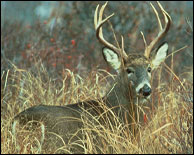
|
Need Mississippi hunting leases, mid-south hunting and fishing spots, Mississippi real estate, homes, farms, ranches, and Mississippi deer hunting, deer hunting land for sale in Mississippi , Thacker Mountain Lodge land and timber property division can supply what you need.
|
|
|

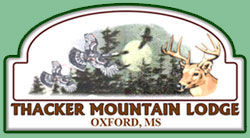 A Mississippi Delta Deer Hunt A Mississippi Delta Deer Hunt
There are five common methods of hunting deer In Mississippi: stalking Mississippi Delta whitetail deer, which consists of following signs and trails of deer; stand hunting, waiting where deer are likely to travel (including tree stands); still hunting, alternately walking silently and waiting concealed in the pursuit of game; line drives, which consists of flushing deer toward a line of hunters; and spot and stalk hunting, which consists of spotting and then stalking the deer. Spot and stalk hunting Mississippi Delta whitetail deer is generally a method of hunting used in places where there are large visible areas, such as mountainous terrain where a person can see across canyons. The other four methods of hunting are used in places such as rolling hills or in country that is more level, where a hunter can hardly see over trees or bushes to spot and watch the deer. Scouting and stalking involves following deer sign. The main way to deer hunt in Mississippi is still hunting, Mississippi Delta whitetail deer
Common signs to pursue include deer rubs, scrapes, and tracks. Scrapes are places where bucks scratch the ground and urinate below low hanging branches on the edge of fields. Bucks do this to mark territory and attract female deer. Deer tracks may reveal the size, age, and species of a deer. Rubs are marks on the trunks and low branches of trees which indicate where bucks have rubbed the velvet off their antlers; this leaves a tell-tale mark because it removes tree bark where the deer rubbed. Another purpose for this is to mark territory with a visual signpost.
Another method of deer hunting in Mississippi is dog driving. A dog or pack of dogs is let loose and used to drive deer out of their bedding area to a place where the hunter may get a shot. The main way to deer hunt in Mississippi is still hunting
Thacker Mountain Lodge offers Mississippi guided deer hunts, Mississippi guided delta deer hunts, and Mississippi guide rifle and bow, or archery hunts for Mississippi Whitetail deer.

|

A Mississippi Delta Deer Hunt
Many different weapons are permitted in the Mississippi Delta Whitetail deer hunting season and during certain times of deer season. These include bows, crossbows, rifles, shotguns, pistols, and muzzleloaders.
Archery season, for Mississippi Delta whitetail deer, usually opens weeks or months before a state or locality's gun season and usually is permitted for several weeks or months afterwards. Modern compound bows and recurve bows are used, as well as some primitive recurve and longbows by historical enthusiasts when permitted. Crossbows are often reserved for disabled hunters who are unable to draw a bow, but are allowed to be used in Alabama and Tennessee by anyone disabled or not and in Minnesota, Kansas, and some other states during firearm season. Most bows and crossbows offer an effective accurate range of 30-40 yards. Compound bows are the most popular archery method. Thacker Mountain Lodge offers Mississippi guided deer hunts, Mississippi guided delta deer hunts, and Mississippi guide rifle and bow, or archery hunts for Mississippi whitetail deer.
In the Mississippi Delta, rifles, shotguns, and pistols are all commonly used for hunting Mississippi Delta Whitetail deer . Most regions place limits on the minimum caliber or gauge to be used; rimfire rifles and centerfires under .22 caliber are often prohibited due to ethical concerns, although they have been used to hunt deer and larger game in some cases. Some areas of the United States prohibit rifle hunting altogether; most firearms hunters in these areas use 10, 12, or 20 gauge shotguns with buckshot or slug loads. Handguns are also prohibited in many deer hunting situations, but hunters in some areas have success with .357 magnum, .41 Magnum, and .44 Magnum revolvers and larger calibers such as the .500 S&W Magnum and .454 Casull. Specialty hunting handguns like the Thompson Center Arms Contender and Encore are capable of firing many big game cartridges like the .30-06 Springfield and .45-70. Large caliber semiautomatics (such as the Desert Eagle, LAR Grizzly, and many 10mm Auto pistols) also deliver enough power to take deer.
In the Mississippi Delta, Whitetail deer hunting, Muzzleloader hunting is also a common practice. Modern muzzle loading rifles equipped with synthetic stocks, telescopic and fiber optic sights, in-line ignition systems, advanced conical or sabot bullet designs, and black powder substitutes such as Pyrodex are much more effective than the muskets of generations past. However, many traditionalists still use wood stocked, iron sighted rifles with round lead balls and traditional black powder charges.
Thacker Mountain Lodge offers the best Mississippi Guided deer hunts available for the money we charge. From the moment you arrive you will be treated with Southern Hospitality, and shown the utmost respect. Our whitetail deer hunting guides will work hard to help you bag a deer. Whether you are bow hunting for deer or rifle hunting for deer, we will set your stands up in areas where you will have a good chance to harvest a Mississippi Delta whitetail deer.
Mississippi Delta whitetail deer Hunters employ many tools, among which are Camouflage, Tree stands/blinds, Knives, Vehicles, Chainsaws, deer calls, and handheld GPS units. Mississippi Delta whitetail deer Camouflage has been used for ages and while it is very important, it is not essential, especially during gun season when it is required that hunters wear blaze orange clothing.
There are many different types of deer stands, ladder stands, climbers and stationary blinds used by Mississippi Delta whitetail deer hunters. Ladder stands are ladders with a platform on top of them chained to a tree. Climber stands are platforms with a seat that may be carried on your back and then placed usually about 4-8 feet off the ground on a tree. Stationary blinds, built from wood and other materials are meant to be a durable and long-lasting blind either on a stand or on the ground, depending on the terrain. In most localities hunters may not take down a deer easily or legally without using certain weapons when they are permitted. Knives are often used for skinning and field dressing deer, by Mississippi Delta whitetail deer hunters.

|

Mississippi Whitetail Deer Guided Hunts
The Mississippi Delta, or Mississippi Deer, White-tailed deer (Odocoileus virginianus), also known as the Virginia deer, or simply as the Whitetail, is a medium-sized deer native to all but five states in the United States, Canada, Mexico, Central America, and northern portions of South America as far south as Peru. It has also been introduced to New Zealand and some countries in Europe such as Finland and Czech Republic. Thacker Mountain Lodge offers Mississippi White-tailed Deer Guided Hunts, and Mississippi Delta Whitetail deer hunts, and Mississippi deer hunts.
The species is most common east of the Rocky Mountains, and is absent from much of the western United States, including Nevada, Utah, California, Hawaii, and Alaska (though its close relatives, the mule deer and black-tailed deer (Odocoileus hemionus), can be found there). It does, however, survive in aspen parklands and deciduous river bottomlands within the central and northern Great Plains, and in mixed deciduous riparian corridors, river valley bottomlands, and lower foothills of the Northern Rocky Mountain Regions from Wyoming to Southeastern British Columbia. The conversion of land adjacent to the Northern Rocky Mountains into agriculture use and partial clear-cutting of coniferous trees (resulting in widespread deciduous vegetation) has been favorable to the white-tailed deer and has pushed its distribution to as far north as Prince George, British Columbia. Populations of deer around the Great Lakes have also expanded their range northwards, due to conversion of land to agricultural uses favoring more deciduous vegetation, and local caribou and moose populations. The westernmost population of the species, known as the Columbian white-tailed deer, once was widespread in the mixed forests along the Willamette and Cowlitz River Valleys of Western Oregon and southwestern Washington, but today its numbers have been considerably reduced, and it is classified as near-threatened. . Thacker Mountain Lodge offers Mississippi White-tailed Deer Guided Hunts, and Mississippi Delta Whitetail deer hunts, and Mississippi deer hunts.
White-tailed deer are generalists and can adapt to a wide variety of habitats. The largest deer occur in the temperate regions of Canada and United States. The Northern white-tailed deer (borealis), Dakota white-tailed deer (dacotensis), and Northwest white-tailed deer (ochrourus) are some of the largest animals with large antlers. The smallest deer occur in the Florida Keys and much of Central America and in South America. Deer from Central and South America generally have smaller tails and antlers. Thacker Mountain Lodge offers Mississippi White-tailed Deer Guided Hunts, and Mississippi Delta Whitetail deer hunts, and Mississippi deer hunts.
Although most often thought of as forest animals depending on relatively small openings and edges, white-tailed deer can equally adapt themselves to life in more open prairie, savanna woodlands, and sage communities as in the Southwestern United States, Northern Mexico, and Colombia and Venezuela. These savanna-adapted deer have relatively large antlers in proportion to their body size and large tails. Also, there is a noticeable difference in size between male and female deer of the savannas. The Texas white-tailed deer (texanus) of the prairies and oak savannas of Texas and parts of Mexico, are the largest savanna-adapted deer in the Southwest with impressive antlers that may rival deer found in Canada and Northern United States. There are also populations of Arizona (couesi) and Carmen Mountains (carminis) white-tailed deer that inhabit montane mixed oak and pine woodland communities that are surrounded by lowland deserts. The Arizona and Carmen Mountains deer are smaller but may also have impressive antlers, considering their size. The white-tailed deer of the Llanos region of Colombia and Venezuela (apurensis and gymnotis) have antler dimensions that are similar to the Arizona white-tailed deer. Thacker Mountain Lodge offers Mississippi White-tailed Deer Guided Hunts, and Mississippi Delta Whitetail deer hunts, and Mississippi deer hunts.

|

Mississippi Whitetail Deer Behavior and Reproduction
Mississippi Whitetail deer Females enter estrus, colloquially called the rut, in the fall, normally in late October or early November, triggered mainly by declining photoperiod. Sexual maturation of females depends on population density. Mississippi Whitetail deer Females can mature in their first year, although this is unusual and would occur only at very low population levels. Most Mississippi Whitetail deer females mature at one or, sometimes, two years of age. Most are not able to reproduce until six months after they mature.
There are several natural predators of Mississippi Delta white-tailed deer. Gray wolves, cougars, american alligators and (in the tropics) jaguars are the more effective natural predators of adult deer. Bobcats, canadian lynxes, bears and packs of coyotes usually will prey on deer fawns, but they do take adults (though usually when infirm). Lynxes, coyotes and bobcats are most likely to take adult deer when the ungulates are weakened by winter weather. The general extirpation of natural deer predators over the East Coast (only the coyote remains widespread) is believed to be a factor in the overpopulation issues with this species. Many scavengers rely on deer as carrion, including New World vultures, hawks, eagles, foxes and corvids (the later three may also rarely prey on deer fawns). Thacker Mountain Lodge offers Mississippi guided deer hunts, Mississippi guided delta deer hunts, and Mississippi guide rifle and bow, or archery hunts for Mississippi whitetail deer.
Mississippi Delta Whitetail Buck deer compete for the opportunity of breeding females. Sparring among males determines a dominance hierarchy. Mississippi Delta Whitetail Buck deer will attempt to copulate with as many females as possible, losing physical condition since they rarely eat or rest during the rut. The general geographical trend is for the rut to be shorter in duration at increased latitude. There are many factors as to how intense the "rutting season" will be. Air temperature is a major factor of how intense the action will be. Anytime the temperature rises above 40 degrees Fahrenheit, the males will do much less traveling looking for females, or they will be subject to overheating or dehydrating. Another factor for the strength in rutting activity is competition. If there are numerous males in a particular area, then they will compete more for the females. If there are fewer males or more females, then the selection process will not need to be as competitive.
Females give birth to one, two or even possibly three spotted young, known as fawns in mid to late spring, generally in May or June. Fawns lose their spots during the first summer and will weigh from 44 to 77 pounds (20 to 35 kg) by the first winter. Male fawns tend to be slightly larger and heavier than females.
Mississippi Delta Whitetail Buck deer communicate in many different ways including sounds, scent, body language, and marking. All whitetail deer are capable of producing audible noises, unique to each animal. Fawns release a high pitched squeal, known as a bleat, to call out to their mothers. Does also bleat. Grunting produces a low, guttural sound that will attract the attention of any other deer in the area. Both does and bucks snort, a sound that often signals danger. As well as snorting, bucks also grunt at a pitch that gets lower with maturity. Bucks are unique, however, in their grunt-snort-wheeze pattern that often shows aggression and hostility. Another way Mississippi Delta Whitetail Buck deer communicate is with their white tail. When a Mississippi Delta Whitetail Buck deer is spooked it will raise its tail to warn the other deer in the area that can see them.
Mississippi Delta Whitetail Buck deer possess many glands that allow them to produce scents, some of which are so potent they can be detected by the human nose. Four major glands are the pre-orbital, forehead, tarsal, and metatarsal glands. It was originally thought that secretions from the pre-orbital glands (in front of the eye) were rubbed on tree branches; recent research suggests this is not so. It has been found that scent from the forehead or sudoriferous glands (found on the head, between the antlers and eyes) are used to deposit scent on branches that overhang "scrapes" (areas scraped by the deer's front hooves prior to rub-urination). The tarsal glands are found on the upper inside of the hock (middle joint) on each hind leg. Scent is deposited from these glands when deer walk through and rub against vegetation. These scrapes are used by bucks as a sort of "sign-post" by which bucks know which other bucks are in the area, and to let does know that a buck is regularly passing through the area - for breeding purposes. The scent from the metatarsal glands, found on the outside of each hind leg, between the ankle and hooves, my be used as an alarm scent.
Throughout the year Mississippi Delta Whitetail Buck deer will rub-urinate, a process during which a deer squats while urinating so that urine will run down the insides of the deer's legs, over the tarsal glands, and onto the hair covering these glands. Bucks rub-urinate more frequently during the breeding season. Secretions from the tarsal gland mix with the urine and bacteria to produce a strong smelling odor. During the breeding season does release hormones and pheromones that tell bucks that a doe is in heat and able to breed. Bucks also rub trees and shrubs with their antlers and head during the breeding season, possibly transferring scent from the forehead glands to the tree, leaving a scent other deer can detect.
Mississippi Delta Whitetail Buck deer uses Sign-post marking (scrapes and rubs) are a very obvious way that whitetail deer communicate. Although bucks do most of the marking, does visit these locations often. To make a rub, a buck will use its antlers to strip the bark off of small diameter trees, helping to mark his territory and polish his antlers. To mark areas they regularly pass through bucks will make scrapes. Often occurring in patterns known as scrape lines, scrapes are areas where a buck has used its front hooves to expose bare earth. They often rub-urinate into these scrapes, which are often found under twigs that have been marked with scent from the forehead glands. Thacker Mountain Lodge offers Mississippi guided deer hunts, Mississippi guided delta deer hunts, and Mississippi guide rifle and bow, or archery hunts for Mississippi whitetail deer. Call today to book your hunt.
Whitetailed deer are generalists and can adapt to a wide variety of habitats. The largest deer occur in the temperate regions of Canada and United States. The Northern white-tailed deer (borealis), Dakota white-tailed deer (dacotensis), and Northwest white-tailed deer (ochrourus) are some of the largest animals with large antlers. The smallest deer occur in the Florida Keys and much of Central America and in South America. Deer from Central and South America generally have smaller tails and antlers. Thacker Mountain Lodge offers Mississippi White-Tailed Deer Guided Hunts, and Mississippi Delta Whitetail deer hunts, and Mississippi deer hunts.

|

Need Mississippi hunting leases, mid-south hunting and fishing spots, Mississippi real estate, homes, farms, ranches, and Mississippi deer hunting, deer hunting land for sale in Mississippi , Thacker Mountain Lodge land and timber property division can supply what you need.

|
|
|
|